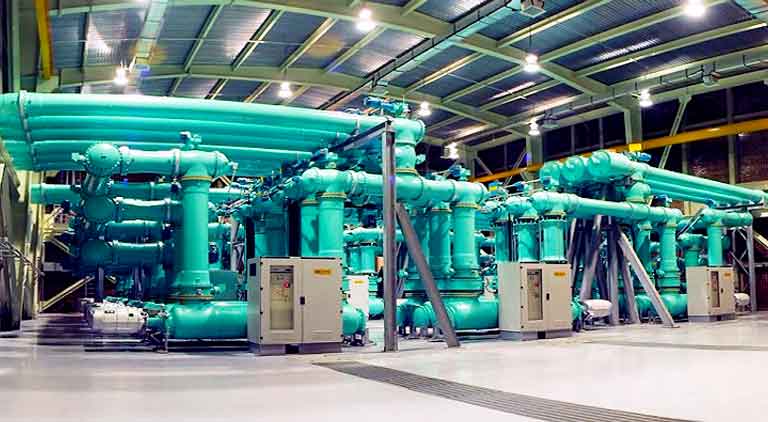Adopting IEEE C37.122 standards for high-voltage gas-insulted substation (GIS)
By EPR Magazine Editorial March 4, 2020 10:55 am IST
By EPR Magazine Editorial March 4, 2020 10:55 am IST

Routine tests, often referred to as production tests, are performed to ensure that each gas-insulated substation (GIS) operates as it has been designed and type-tested for. The routine tests are performed for each GIS after assembly and marks a major quality gate before the GIS leaves the factory. The test parameters are based on the type test results, which means that within certain tolerances, the routine tests need to reflect the type test data. The following sections briefly describe routine tests included in the IEEE C37.122 standard.
Dielectric tests
Dielectric tests are done after the mechanical routine testing and demonstrate the dielectric performance of the GIS, ensuring the correct assembly, correctly manufactured parts from a dielectric point of view, and the absence of particles and other contaminants
Power frequency dielectric test
For routine tests, the dielectric test is a power frequency withstand voltage test. Impulse testing, such as lighting and switching impulse, is not typically part of the routine testing. At minimum functional SF6 pressure, the following conditions are tested: phase-to-ground, phase to-phase (in the case of three phases in one enclosure design), and across open switching devices. Successfully withstanding the one-minute withstand level without a disruptive discharge is the main criterion to mark that the test has been passed successfully.
Measurement of partial discharges
This is performed to detect possible material and manufacturing defects. The measurement of partial discharges shall be performed with dielectric tests after mechanical routine tests. The test shall be carried out on all components of the GIS.
Measurement of the resistance of the main circuits Typically, the voltage drop or resistance of main circuits are measured using a DC current of 100 A. The test data should be within a 20 percent tolerance band compared with the type test data.
Tightness tests
Using devices such as SF6 piping, adaptation of SF6 leakage detectors, all areas of enclosures assemblies, SF6 gauges, and SF6 density monitoring will be checked for leaks.
Pressure tests of enclosures
After complete machining of enclosures, pressure tests are made at 1.3 times the design pressure for welded aluminium and welded steel enclosures and at 2 times the design pressure fore cast enclosures. Automated test stations facilitate the inclusion of a tightness test using helium after the pressure test of the enclosure. The standard test pressure shall be one point three times design pressure for welded aluminium and welded steel enclosures. Two times design pressure for cast aluminium and composite aluminium enclosures. The test pressure shall be maintained for at least one minute. No rupture or permanent deformation should occur during this test.
Tests on auxiliary and control circuits
These tests confirm that during manufacturing, all wiring has been done correctly according to the related circuit diagrams. Auxiliary and control circuits shall conform to the schematics, wiring diagrams, and technical data provided by the manufacturer. Technical data may include the number, class, type, capacity of available contacts, and electrical power of shunt releases (other than auxiliary and control contacts, electrical power of shunt releases, etc.). This test has the following sections:
Functional tests
A functional test of all low-voltage circuits shall be made to verify the proper functioning of auxiliary and control circuits in conjunction with the other parts of the switchgear. The test procedures depend on the nature and complexity of the low-voltage circuits of the device.
Verification of protection against electrical shock protection This will be done against direct contact with the main circuit, and safe accessibility to the auxiliary and control equipment parts liable to be touched during normal operation shall be checked by visual inspection.
Dielectric tests on auxiliary and control circuits
Only power frequency withstand voltage tests shall be performed. All control wiring associated with current and linear coupler transformer secondary and potential device secondary shall receive a power frequency withstand test of 2,500 V for one minute. All other control wiring shall receive a power frequency withstand test of 1,500 V for one minute or 1,800 V for one second.
Pressure tests on partitions
Partitions are gas-tight insulators that separate one gas compartment from the other. They allow full pressure on one side and vacuum on the other. Each partition has to be tested to twice that of the design pressure. It has to be ensured that the weakest mechanical direction of the device is being considered for the test. This test verifies that the partition has been manufactured correctly to withstand the pressure the partition is designed for. Partitions will also be tested to the dielectric withstand capability and a sensitive partial discharge measurement. Pressure tests shall be made on enclosures after complete machining. Each partition shall be subjected to a pressure test at twice the design pressure for one minute in the weakest direction. For the pressure test, the partition shall be secured in exactly the same manner as in service. The partition shall not show any sign of over stress or leakage.
For more information, visit:
www.switchgearcontent.com
We use cookies to personalize your experience. By continuing to visit this website you agree to our Terms & Conditions, Privacy Policy and Cookie Policy.